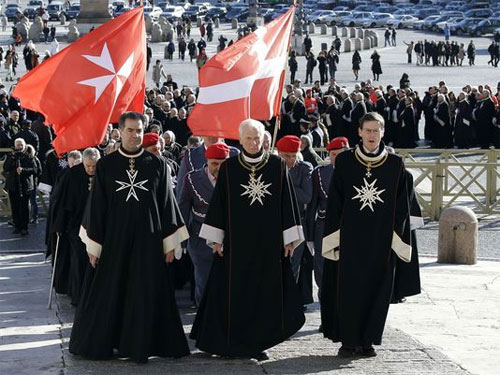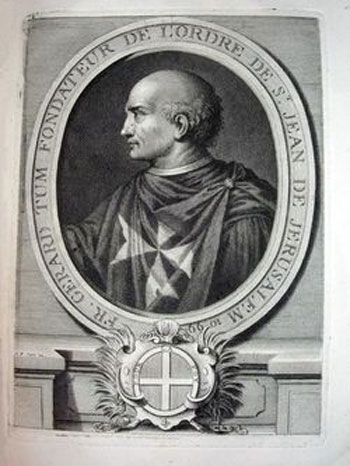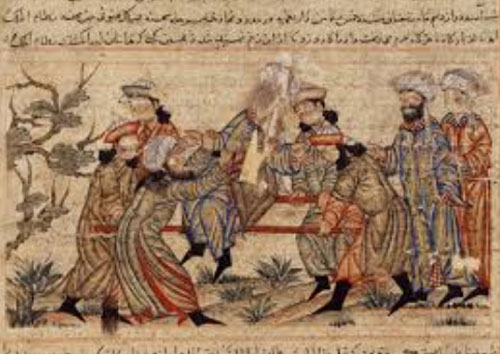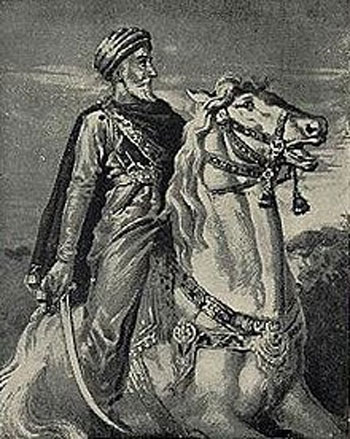Men in Black: The Hidden History of the Knights of Malta (1)
In all the annuals of conspiracy literature there is probably no other organization more misunderstood and misrepresented than the Sovereign Military Order of Malta (SMOM), more commonly known as the Knights of Malta. The Maltese knights trace their origins back to the Order of the Knights of the Hospital of Saint John of Jerusalem, more commonly known simply as the Knights Hospitaller. For a time they were also known as the Knights of Cyprus and Rhodes and a host of other such variations. The Order has an almost totally unbroken lineage that stretches back to the eleventh century, hundreds of years before many of the more common bugaboos of conspiracy literature can be reliably dated.

For the sake of brevity we will probably not delve too much into the modern intrigues of SMOM or those of the countless splinter groups and mimic orders the Maltese knights have spawned over the years. Still, this leaves us with a rather extensive amount of history to cover and as such, we shall mainly focus on the aspects of the Order that no doubt most interest our readers: namely, its ties to espionage and the occult. It is for this reason the article is entitled “Men in Black” (MIB).
The Men in Black are of course staples of UFO literature, but reports of them predate the modern era. Gray Baker, one of the earliest MIB chroniclers, noted:
„Dennis Stanley, in a chapter that appeared in The Truth About the Men in Black… believes that ‘visits by unknown agents are seeded throughout UFO literature and newspaper accounts of flying saucer sightings’. For many years, they were overlooked or not recognized for what they were. Today, just about every UFO investigator has encountered these Men in Black. The history of demonology, witchcraft, and the occult filled with similar incidents, leading one to speculate that the UFO phenomena are at least partly ‘psychic’ in nature.
UFO magazine editor Allen H. Greenfield has pointed out that there is usually a consistent reference associating the term ‘Black Man’ with the Devil, along with a mention of an Indian-like appearance supposedly attributed to the Devil by witches. Greenfield has noted that there was a concentration of such cases beginning at the time of the Elizabethan, post-Reformation era in the 1600s. Several occult volumes classify these beings into a group of their own and refer to them as Men in Black, Demons, Devils, Apparitions, or Black Men – the latter being the most commonly used.
The writings of arch which-hunter Cotton Mather mention a ‘Black Man’ associated with the Indians. And there was mention of a man dressed in black during the witch trials in Salem, Massachusetts.” (Men in Black: The Secret Terror, Gray Baker, pg.41)
Historically these Men in Black were viewed as tricksters and tempters, and often appeared in relation to witchcraft and ritual magic. But in modern times, with the advent of UFO lore, they have become suppressors par excellence. Numerous reports exist of them harassing UFO researchers, stealing evidence and so on in an effort to hide the truth from the public. This perception has seeped into pop culture with a vengeance, eventually inspiring a film series. The influence of the MIBs is felt beyond even UFO-related material, with The Matrix memorably using MIBs (dubbed “Agents“) as suppressors of the Demiurgic nature of reality.
Curiously, the black grabbed Maltese knights may have been serving a similar function for centuries in regards to the occultism and arcane. With that in mind, let us leap head long into the Order’s mysterious origins.
Murky Beginnings in the Holy Land
It is generally agreed that the Knights Hospitaller grew out of a hospital established in Jerusalem to treat Christian pilgrims via papal edict in the seventh century. Some four hundred years later, in the early eleventh century, it was destroyed by Caliph Al-Hakim bi-Amr Allah. During the 1020s, efforts were made to rebuild it with the project falling under the sway of the Benedictine order.
The stage was set for the appearance of the Knights Hospitaller when an alleged lay brother of the Benedictine order known only as Gerard was appointed to head the Hospital of Saint John at some time around 1080. “Blessed” Gerard is the mysterious first Grand Master of the Knights Hospitaller. Virtually nothing is known about his life prior to his arrival in the Holy Land, though it has long been claimed that his birthplace was Amalfi.
What is known is that he first rose to prominence during the Siege of Jerusalem in 1099. Reportedly, his assistance proved to be invaluable to the Christian Crusaders and for reasons that went beyond medical care.
“One of the ejected Christians was Blessed Gerard, master of the Amalfi hostel in the city, who immediately approached the Christian leaders to assist them with first hand knowledge of the layout and the defenses of Jerusalem. Needless to say, his intelligence was indeed most welcome. The crusading leaders ensured that their plans for the city’s fall would encompass and indeed utilize Gerard’s inside information.” (The Sword and the Green Cross, Max J. Ellul, pgs. 76-77)

Blessed Gerard
Thus, the Order’s proto history can be linked directly to espionage. This is a well the Order would return to time and again, as we shall see. But moving along.
Needless to say, the Crusader leaders did not forget Blessed Gerard’s good work and his Hospital soon found itself the recipient of lavish donations. However it was not till Garard’s successor, Raymond du Puy, that the true Hospitaller order began to emerge. It was du Puy that transformed the Order’s mission from simply administering medical care to pilgrims (apparently with some intelligence gathering) to actively guarding them. To this end, the famed Hospitaller knights arrived.
Not only did these endeavors receive Papal blessings in 1113, but recognition from one of the premier European powers of the era fairly early in the game. In 1185, 67 years after du Puy succeeded Blessed Gerard as Grand Master and militarized the Order, it received protection and a charter of privileges from Frederick Barbarossa, arguably the greatest Holy Roman Emperor of the Middle Ages. This would mark the beginning of a longstanding relationship between the Order and the Holy Roman Empire that continues in a fashion to this day. The Order would grow especially close to the Habsburg dynasty that ruled the Holy Roman Empire for well over four hundred years.
One such Holy Roman Emperor, Charles V, granted the Knights Hospitaller Malta in 1530 after they lost their holdings in Rhodes. In 1607, the Grand Master was awarded the status of Reichsfurst, Prince of the Holy Roman Empire. The connection between the Order and the Habsburg dynasty continued well into the later half of the twentieth century, as shows the examination of the mysterious organization known as Le Cercle, which featured ample backing from both the Maltese knights and the Habsburgs.
In the Holy Lands the Order frequently rubbed shoulders with two darlings of conspiracy literature: the Knights Templar and the Nizari, more commonly referred to as the Assassins or Hashshashins. As to the latter, it would appear that the Hospitaller ad the Nizari established a relationship so close by the late thirteenth century that it reportedly bordered on heresy.
“… By 1228, the Syrian Nizaris had in fact become tributaries to the Hospitallers under the terms of a cooperative pact, while they continue to pay tribute to the Templars. It was also around this time that the Nizaris began to lend occasional support to the military orders in their campaigns against some of the Christian rulers of the Latin states; and at least the Hospitallers reciprocated by defending the Nazaris against the encroaching forces of Antioch and Tripoli. The Nizari involvement in the Hospitaller campaign of 1230 launched by Krak des Chevaliers against Bohemond IV of Antioch represented one such instance of cooperation.
It was against this background that Bohemond V (1233-57), the next prince of Antioch and Raymond’s brother, wrote Pope Gregory IX complaining that the Grand Master of the Hospitallers was then in league with the ‘Assassins.’ In response to this complaint, on 26 August 1236, Pope Gregory wrote to the Archbishop of Tyre and the bishops of Sidon and Beirut insisting that the Hospitalers should terminate any compromising connections with the Assassins, the enemies of God and of the Christian name, who formerly dared to slay treacherously Raymond [son of Bohemond IV]… and many other magnates and Catholic princes, and are striving to overcome our faith by force… and what is far graver still the aforesaid Assassins, on account of the promise made by the after mentioned Master and brethren [of the Hospital] to support and protect them Christian attacks, and undertaken to pay them a certain sum of money every year. Therefore we have sent them orders writing to desist from defending these same Assassins… And so we now charge you that if the said Master and brethren should fail to observe this our command, you shall compel them to abandon this understanding by the censures of the Church, without right of appeal, after giving them due warning.” (The Assassin Legends, Farhad Daftary, pgs. 75-76)

The Nizari showing why they are forever remembered as “Assassins”
Over the years there has been much speculation over the Nizari, who became infamous throughout Christian and Islamic lands during the Middle Ages for their curious ability to assassinate heads of state (hence the reason why the word “assassin” derives from “Hashshashins”). Frequently these assassinations occurred in broad daylight and in crowded place where the assassin had no chance to escape after the deed was done. As such, it was common for a Nizari to die immediately after taking out their target.
The killers were reportedly so stoic in performing their deeds, despite their own certain death, that the methods employed to produce such dedicated killers has spurred much interest over the years. The CIA itself even referenced the legendary founder of the Assassins branch of the Nizari, Hassan-i-Sabbah, in an early assassination manual.
“… A 1952 draft version of the manual describes a man named Hasan-Dan-Sabah who used the drug hashish to ‘induce motivation in his followers, who were assigned to carry out political and other murders, usually at the cost of their lives.’ Hasan-Dan-Sabah’s credo with his closest initiates and most skilled assassins was: ‘Nothing is true, everything is permitted.’ States the CIA’s manual, ‘Assassination is a term thought to be derived from “Hashish,” a drug similar to marijuana.’ It is certainly intriguing, for a number of reasons, that the Agency included this reference in its assassination manual. First and foremost is the nexus among Hasan-Dan-Sabah (also known as the Old Man of the Mountain), Hassan-I-Sabbah, an Iranian born in 1056 near modern day Tehran, and the Knights Templar, a legendary group that nearly all of the CIA’s founders and earliest employees openly admired and sought to emulate.” (A Terrible Mistake, H.P. Albarelli, Jr., pgs. 263-264)

Hassan-i-Sabbah
Contrary to popular belief, there is no real compelling evidence that Hassan-i-Sabbah used hashish to induce his followers into committing assassinations, or that the Nizari that followed him indulged in it. Most of these allegations likely derive from the reign of Hassan’s great-grandson, Hassan II (the fourth lord of Alamut), in which standards had become much more lax since Hassan’s day.
In point of fact, Hassan-i-Sabbah was known for sobriety and rigid discipline was imposed upon his sect. It was likely this that served as the cornerstone of the sect’s brainwashing, namely relentless religious indoctrination combined with physical deprivation induced by long days and lack of proper nutrition. Such methods are still used to good effect by modern day cults such as the Unification Church of Sun Myung Moon.
Still, it is curious that the CIA would look to the Nizari in the early 1950s for inspiration in conducting assassinations at the same time their numerous behavioral modification experiments were in fools swing. Even more curious is the fact that many key early members of the CIA such as Allen Dulles and James Jesus Angleton had had close dealings with the Knights of Malta, the direct descendants of the Medieval Knights Hospitaller, who were warned by the papacy for their close ties to the Nizari, the “enemies of God and the Christian name.” As is often the case, many have continued to focus on the interest the early CIA had in the Knights Templar while ignoring the actual membership many key CIA officials had in the Maltese knights.
Read the second part of the article
yogaesoteric
April 9, 2019
Also available in:
 Français
Français
